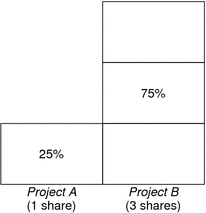Chapter 8
Fair Share Scheduler (Overview)
The analysis of workload data can indicate that a particular workload or group of workloads is monopolizing CPU resources. If these workloads are not violating resource constraints on CPU usage, you can modify the allocation policy for CPU time on the system. The fair share scheduling class described in this chapter enables you to allocate CPU time based on shares instead of the priority scheme of the timesharing (TS) scheduling class.
This chapter covers the following topics.
To begin using the fair share scheduler, see Chapter 9, Administering the Fair Share Scheduler (Tasks).
Introduction to the Scheduler
A fundamental job of the operating system is to arbitrate which processes get access to the system's resources. The process scheduler, which is also called the dispatcher, is the portion of the kernel that controls allocation of the CPU to processes. The scheduler supports the concept of scheduling classes. Each class defines a scheduling policy that is used to schedule processes within the class. The default scheduler in the Solaris Operating System, the TS scheduler, tries to give every process relatively equal access to the available CPUs. However, you might want to specify that certain processes be given more resources than others.
You can use the fair share scheduler (FSS) to control the allocation of available CPU resources among workloads, based on their importance. This importance is expressed by the number of shares of CPU resources that you assign to each workload.
You give each project CPU shares to control the project's entitlement to CPU resources. The FSS guarantees a fair dispersion of CPU resources among projects that is based on allocated shares, independent of the number of processes that are attached to a project. The FSS achieves fairness by reducing a project's entitlement for heavy CPU usage and increasing its entitlement for light usage, in accordance with other projects.
The FSS consists of a kernel scheduling class module and class-specific versions of the dispadmin(1M) and priocntl(1) commands. Project shares used by the FSS are specified through the project.cpu-shares property in the project(4) database.
Note - If you are using the project.cpu-shares resource control on a Solaris system with zones installed, see Zone Configuration Data, Resource Controls Used in Non-Global Zones, and Using the Fair Share Scheduler on a Solaris System With Zones Installed.
CPU Share Definition
The term "share" is used to define a portion of the system's CPU resources that is allocated to a project. If you assign a greater number of CPU shares to a project, relative to other projects, the project receives more CPU resources from the fair share scheduler.
CPU shares are not equivalent to percentages of CPU resources. Shares are used to define the relative importance of workloads in relation to other workloads. When you assign CPU shares to a project, your primary concern is not the number of shares the project has. Knowing how many shares the project has in comparison with other projects is more important. You must also take into account how many of those other projects will be competing with it for CPU resources.
Note - Processes in projects with zero shares always run at the lowest system priority (0). These processes only run when projects with nonzero shares are not using CPU resources.
CPU Shares and Process State
In the Solaris system, a project workload usually consists of more than one process. From the fair share scheduler perspective, each project workload can be in either an idle state or an active state. A project is considered idle if none of its processes are using any CPU resources. This usually means that such processes are either sleeping (waiting for I/O completion) or stopped. A project is considered active if at least one of its processes is using CPU resources. The sum of shares of all active projects is used in calculating the portion of CPU resources to be assigned to projects.
The following formula shows how the FSS scheduler calculates per-project allocation of CPU resources.
Figure 8-1 FSS Scheduler Share Calculation

When more projects become active, each project's CPU allocation is reduced, but the proportion between the allocations of different projects does not change.
CPU Share Versus Utilization
Share allocation is not the same as utilization. A project that is allocated 50 percent of the CPU resources might average only a 20 percent CPU use. Moreover, shares serve to limit CPU usage only when there is competition from other projects. Regardless of how low a project's allocation is, it always receives 100 percent of the processing power if it is running alone on the system. Available CPU cycles are never wasted. They are distributed between projects.
The allocation of a small share to a busy workload might slow its performance. However, the workload is not prevented from completing its work if the system is not overloaded.
CPU Share Examples
Assume you have a system with two CPUs running two parallel CPU-bound workloads called A and B, respectively. Each workload is running as a separate project. The projects have been configured so that project A is assigned SA shares, and project B is assigned SB shares.
On average, under the traditional TS scheduler, each of the workloads that is running on the system would be given the same amount of CPU resources. Each workload would get 50 percent of the system's capacity.
When run under the control of the FSS scheduler with SA=SB, these projects are also given approximately the same amounts of CPU resources. However, if the projects are given different numbers of shares, their CPU resource allocations are different.
The next three examples illustrate how shares work in different configurations. These examples show that shares are only mathematically accurate for representing the usage if demand meets or exceeds available resources.
Example 1: Two CPU-Bound Processes in Each Project
If A and B each have two CPU-bound processes, and SA = 1 and SB = 3, then the total number of shares is 1 + 3 = 4. In this configuration, given sufficient CPU demand, projects A and B are allocated 25 percent and 75 percent of CPU resources, respectively.

Example 2: No Competition Between Projects
If A and B have only one CPU-bound process each, and SA = 1 and SB = 100, then the total number of shares is 101. Each project cannot use more than one CPU because each project has only one running process. Because no competition exists between projects for CPU resources in this configuration, projects A and B are each allocated 50 percent of all CPU resources. In this configuration, CPU share values are irrelevant. The projects' allocations would be the same (50/50), even if both projects were assigned zero shares.

Example 3: One Project Unable to Run
If A and B have two CPU-bound processes each, and project A is given 1 share and project B is given 0 shares, then project B is not allocated any CPU resources and project A is allocated all CPU resources. Processes in B always run at system priority 0, so they will never be able to run because processes in project A always have higher priorities.

FSS Configuration
Projects and Users
Projects are the workload containers in the FSS scheduler. Groups of users who are assigned to a project are treated as single controllable blocks. Note that you can create a project with its own number of shares for an individual user.
Users can be members of multiple projects that have different numbers of shares assigned. By moving processes from one project to another project, processes can be assigned CPU resources in varying amounts.
For more information on the project(4) database and name services, see project Database.
CPU Shares Configuration
The configuration of CPU shares is managed by the name service as a property of the project database.
When the first task (or process) that is associated with a project is created through the setproject(3PROJECT) library function, the number of CPU shares defined as resource control project.cpu-shares in the project database is passed to the kernel. A project that does not have the project.cpu-shares resource control defined is assigned one share.
In the following example, this entry in the /etc/project file sets the number of shares for project x-files to 5:
x-files:100::::project.cpu-shares=(privileged,5,none) |
If you alter the number of CPU shares allocated to a project in the database when processes are already running, the number of shares for that project will not be modified at that point. The project must be restarted for the change to become effective.
If you want to temporarily change the number of shares assigned to a project without altering the project's attributes in the project database, use the prctl command. For example, to change the value of project x-files's project.cpu-shares resource control to 3 while processes associated with that project are running, type the following:
# prctl -r -n project.cpu-shares -v 3 -i project x-files |
See the prctl(1) man page for more information.

 Previous
Previous